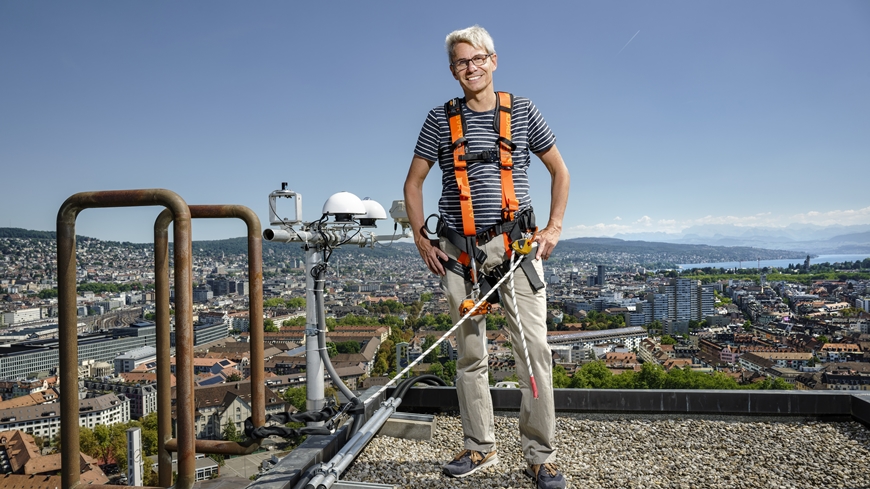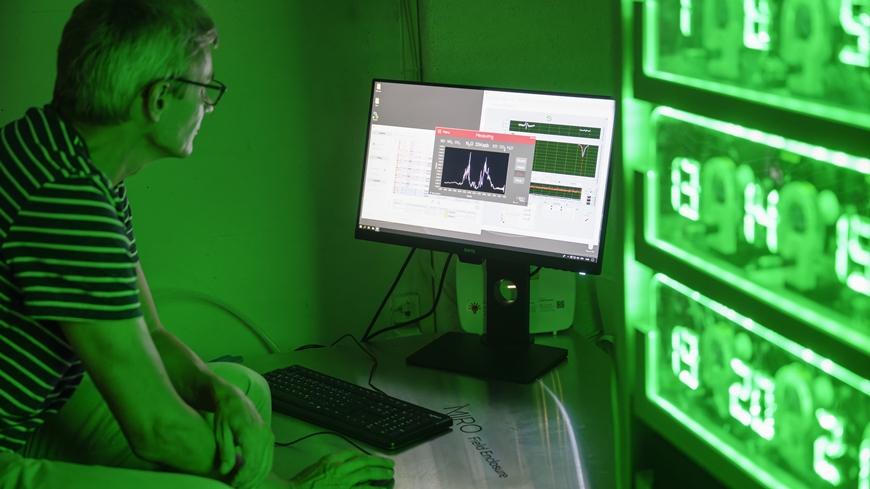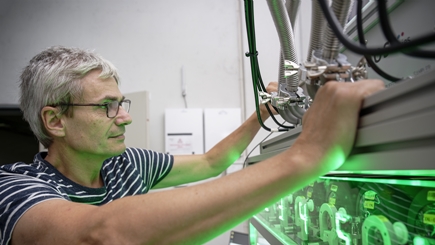Distinguished Senior Researcher: Dominik Brunner
Scouting the atmosphere
Internationally recognized atmospheric scientist and Distinguished Senior Researcher at Empa: Dominik Brunner is a scientist who has explored his subject area from many angles – with a weatherproof motivation and curiosity that drives him to this day.

If you read an article about air pollution in Switzerland, about greenhouse gases or climate change, you are most likely to find thoughts and ideas from Dominik Brunner, head of the Atmospheric Modeling and Remote Sensing group at Empa since 2006, professor of tropospheric chemistry at ETH Zurich. Involved in satellite missions of the European Space Agency ESA and in numerous international research projects, co-founder of the Swiss measurement network for greenhouse gases and much more. And honored several times for his research, including as one of Empa's very few Distinguished Senior Researcher.
How did that come about? Steadily and patiently. The topic of the environment had already interested Dominik Brunner in his youth in the 1980s, when the environmental movement emerged – with the slogan "jute instead of plastic," as he recounts with a smile, with waste avoidance, green initiatives and the attempt by "activists" at the time to join forces to put Migros – one of the largest retail companies in Switzerland and organized as a cooperative –, as cooperative members, more firmly on an environmentally friendly course.
Nevertheless, Brunner did not become a treehugger with political ambitions, but studied physics at the ETH Zurich. In his diploma thesis, he built a device for measuring hydrogen peroxide (H2O2) in ambient air; as a PhD student he continued with this topic – a fully automatic measuring system that was used on board a Swissair aircraft. The focus of the atmospheric scout: nitrogen oxides and ozone, which were already important environmental factors at the time.
They were to prove a door opener. The result was a publication in the renowned journal Science and an award from ETH Zurich – for the discovery that some phenomena are more widespread than previously assumed. For example, large-scale nitrogen oxide plumes in the region of the tropopause, the boundary layer above the near-Earth troposphere – caused by lightning and upward transport of air pollutants from the Earth's surface into thunderclouds.
Towers, aircraft, satellites ...

Since new insights always raise new questions, several aircraft measurement campaigns followed during two postdoctoral positions at the Royal Netherlands Meteorological Institute (KNMI) and ETH Zurich – in Canada, Brazil and Australia, where a former Russian spy plane was used that flew at altitudes of up to 20 kilometers. "We were also concerned with nitrogen oxide production by lightning," Brunner recounts, "the planes flew into thunderclouds; that surely had a certain adventurous twist to it."
A highlight in his career. As was, later on, the CarboCount-CH project, in which a Swiss team led by Brunner equipped the Beromünster tower – the former radio station, which is far away from major sources of pollution – with innovative measuring equipment. "That was Switzerland's first greenhouse gas monitoring network," the researcher recounts, "the station is still up and running and is now even part of the National Air Pollutant Monitoring Network, NABEL." Together with research stations such as Jungfraujoch and others, NABEL is the Swiss "hardware" for exploring environmental hazards and climate risks.
Opportunities for pioneering work, it seems, frequently came Dominik Brunner's way. And he seized them – out of sheer curiosity. An important virtue for a researcher, he reckons – as is the courage to pursue completely original ideas. Take satellites, for example: Brunner got his first inspiration back at the KNMI in Holland, which was developing the OMI satellite (Ozone Monitoring Instrument) at the time. "There I saw how elegantly you can combine modeling and satellite measurements," he says. And so he delved deeper into the subject and tried to improve the measurements with the help of new algorithms that took into account the fact that different soils, such as grassy areas, reflect sunlight differently to the sensors in the satellite.
Simulated street canyons

It shouldn't stop at this global perspective, though. Since joining Empa, Brunner has increasingly turned his attention to regional and small-scale problems, such as urban air pollution and heat islands: the climate in Zurich. And because the ever-increasing computing power of supercomputers allows ever finer weather models, simulations have been developed right down to individual street canyons.
From orbit to the sidewalk ... – yes, nods Brunner: "I have covered a great many topics and scales." An accumulation of knowledge and experience that he is happy to pass on – whether in lectures, in supervising PhD theses and also as head of a research group. "Working with motivated PhD students is always great, of course," he says, "but actually being the boss doesn't really suit me, especially when it comes to making unpleasant decisions. However, I've grown into this role and now feel quite comfortable with it."
Is there any annoyance at all?
Well, he certainly dislikes some aspects in the debate about climate change: "It's often said that researchers are just stirring up panic to get more research funding," says Dominik Brunner, "that's something that annoys me." After all, the major trends in global warming are now well confirmed – and the fact that there are unanswered questions is by no means disputed. As an example, the climate scientist mentions feedback effects: As it gets warmer, the snow and ice regions melt, especially in the Arctic – more dark surfaces, in other words, which absorb more sunlight and thus in turn accelerate global warming.
On the other hand, as temperatures rise, trees will grow in higher altitudes. The tree line in Switzerland is rising, Brunner says, and the bottom line is that vegetation is growing worldwide – and thus also sequestering more carbon dioxide. But whether such effects will balance things out in the longer term? "After all, vegetation can't migrate at will," he says, "which really worries me: We might even be underestimating the consequences of global warming."
Wouldn't that require more aggressive communication? Also speak plain language politically, like some other climate researchers? Brunner prefers to focus on his research and not to expose himself too much in public – and he doesn't enjoy arguing anyway. Press interviews, well, he gives them – "if they have to be ...", he adds with a smile.
Dominik Brunner
After studying physics at ETH Zurich, Dominik Brunner devoted himself to atmospheric research in the field of nitrogen oxides, climate gases and other areas. He completed a post-doctorate at the Royal Netherlands Meteorological Institute in De Bilt and was a research assistant at the Institute for Atmospheric Science at ETH Zurich. Since 2006, he has headed the Atmospheric Modeling and Remote Sensing Group at Empa. Brunner published papers on modeling and measurement technologies and participated in satellite missions of the European Space Agency (ESA). He is professor of tropospheric chemistry at ETH Zurich and a member of numerous expert committees. Brunner received several awards, for instance, for his PhD thesis, as reviewer for ERC research grant proposals and as a Distinguished Senior Researcher at Empa.
Precise measurements
He'd rather kick off more exciting projects like a Europe-wide measurement campaign that has just started. The EU-funded project ICOS-Cities will take a close look at climate gas emissions in large cities – in Zurich, and later also in Munich and Paris. After all, metropolises are responsible for around 70 percent of climate gas emissions worldwide, according to rough estimates. For the three European cities of different sizes, ICOS-Cities will provide helpful data – also with the help of measurements on a residential tower of Zurich's Hardau II estate, almost 100 meters high, once the city's tallest building.
In addition to conventional measurements of CO2 concentrations, from which emissions are then calculated backwards, another method called eddy covariance is used. Thanks to extremely fast sensors, this allows records of climate gases such as CO2, methane and nitrous oxide to be correlated with measurements of upwind and downwind conditions. This allows the "breathing" of the city to be recorded – and thus conclusions to be drawn about the causes of the emissions. And this data could in turn also reveal how road traffic, for example, affects the city on workdays or on weekends.
An appealing project for the atmospheric scout that will require ideas, curiosity and perseverance until 2025 – in the small circle of environmental scientists, not on the public stage of climate policy. And yet with practical value for people in big cities. "Climate change is certainly the Number 1 topic in atmospheric research," says Dominik Brunner, "and for me, one that is truly dear to my heart."
Air Pollution / Environmental Technology
Phone: +41 58 765 49 44
dominik.brunner@empa.ch
Communication
Phone: +41 58 765 44 54
norbert.raabe@empa.ch
-
Share






